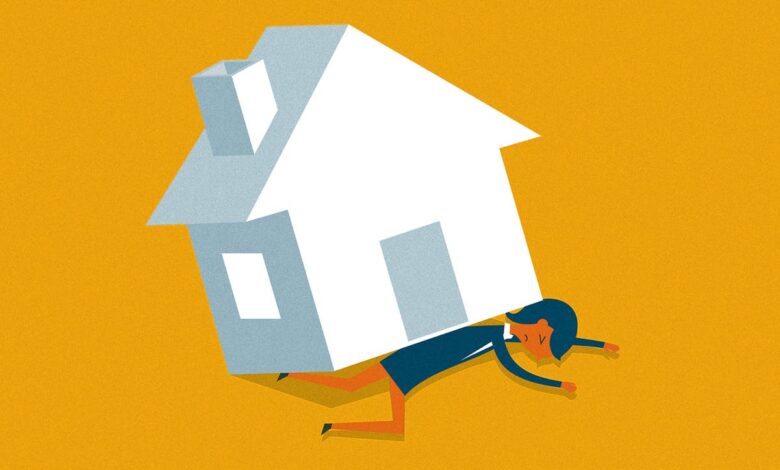Britain’s broken housing system means living inside a sick joke

A fortnight ago, my partner and I asked to renew our tenancy. In reply, the property manager prompted us to “confirm” how much more rent we could “comfortably afford” – because, of course, tenants must be responsible for fluctuations in the housing market, and costs must be passed on to them. We said that there was no increase we could “comfortably afford”, and now we’re waiting – to see if we can stay, or if we’ll be priced out. Anyone whose home life touches the sharp edges of the housing crisis is probably intimately familiar with this kind of waiting, because the experience of dealing with both precarious labour and insecure housing is so unsteady. Unable to plan for the future, you become trapped in the present. You feel a bit like a duck moving its legs underwater, staying still but only through constant effort.
This week, while unsteadily suspended waiting for a response, I have consumed two things. The first: aspirational interior content on Instagram, which my algorithm has been serving me in generous dollops in what can only be a sick joke. This usually has the power to make me nauseous with bitterness and envy, but luckily the second thing I pored over was journalist Kieran Yates’s new book All the Houses I’ve Ever Lived In, which has instead inspired, angered and galvanised me in equal measure.
Part memoir, part manifesto, Yates’s book draws on her personal experience growing up in a broken housing system. By the age of 25, Yates had lived in 20 different houses across the country, and the book is structured as a tour through some of them. Each chapter marks a new address, starting from Southall’s Beresford Road, to Ealing’s Green Man Lane Estate, and on to Meifod Cottage “in the deep countryside of mid-Wales”, before looping back to southeast London’s Amersham Grove, Pepys Road and Peckham Rye. Yet despite being intimate, rich in material details and clearly saturated with love for family, friends and community, Yates’s book is certainly not a work of pure nostalgia. It is an impassioned and intelligent account of the class disparity, racial prejudice and state negligence that riddles the UK housing system, which Yates experienced first-hand.
The personal is always political. The “Beresford Road” chapter takes a tissue box of gold plastic and black faux velvet, “which [Yates’s] nanaji had brought with him from Bahowal”, and uses it as a talisman to discuss global diasporas, racist violence against immigrant communities, the Southall riots, and grassroots activist organisations fighting for anti-racist housing legislation. “Green Man Lane Estate” is about pebbledash and paper-thin walls, and also about legacies of neglect that led directly to the Grenfell Tower fire. Later, the “Pepys Road” chapter develops into an urgent treatise on damp and toxic mould.
“It is important to realise these things are all connected”, Yates writes. Throughout, All the Houses I’ve Ever Lived In shows the housing system not as a “market”, but a fragile ecosystem – encompassing social rented housing, student and temporary accommodation, new build high rises, estates, converted shop fronts and “starter homes”. Similarly, the housing crisis is not siloed into a single issue of house prices and difficulties “getting on the ladder”, as it often is in the mainstream media, but is shown for what it truly is: a complex knot being pulled tight by greed and negligence. “Negligence, after all, can’t be reduced to dodgy buildings,” Yates writes. “It is in the insidious cycle of the media, in political rhetoric, in the slow speed of responses from governments, councils, developers and landlords.” It is everywhere, in other words, and must be fought on all fronts, because what’s at stake is people’s lives.
“I thought it was important to think about housing outside of an asset, as that is often how it’s sold to us,” Yates tells me over the phone the day the book is published. “I thought it was important to think about the idea of home, so we can think beyond the commodity shells that estate agents would often like us to think about property.” Noting that we live in a country “where the overriding political rhetoric is about who gets to be at home in Britain”, Yates also suggests that if we can consider the idea of home and what it means, “it makes it easier to think about community, and ultimately it makes it easier to think about how we look after each other as well”.
Since moving to southeast London in December 2018, I have lived in five rental properties. Over that time I’ve also made rent in a variety of different ways, while attempting to carve out a life as a writer and journalist. So I identified with a lot of Yates’s book, in a way that at times felt deeply solacing and at times felt like a sharp jab in the chest. For starters, her post-uni shared house on Telegraph Hill’s Pepys Road (named after English diarist Samuel Pepys, who, Yates writes in a deliciously pointed footnote, quadrupled his fortune while the plague played havoc among less affluent and more cramped areas of London in 1665 – a year his biographer described as “one of the happiest” of Pepys’ life) is only a stone’s throw from my first room in London: a basement flat with a galley kitchen where one of the counters collapsed and hung from the wall for two months because the landlady, who lived five doors down, wouldn’t reply to our messages about fixing it. Similarly, Yates’s passages about black mould creeping over the walls of her bedroom, or mice waking her up in the night, felt like they could be pulled from my old diaries.
In saying that, I’m really not trying to make this all about me, or frame Yates’s book through the rubric of relatability – I think that is a bad measure for literature and art, and, in any case, Yates’ book is much broader and cleverer than that. But, one of the clever things Yates does is make it clear that all the houses she’s ever lived in are entwined with all the houses every reader has ever lived in. She makes it clear that mould or mice in urban graduate shared housing are symptoms of the same social sickness that forces the most vulnerable in society to live in shipping containers.
“We know that the emotional and psychological effects of housing insecurity are bad, and we know that constant psychic breaks and interruptions are not good for our mental health,” Yates tells me. “We know that the idea of having a landlord breathing down our neck increasing the cost of rent, for example, creates adrenaline and rising cortisol levels. These can have lots of long-term effects, like heart disease, anxiety, and depression, and these all contribute to the mental toll of housing insecurity.” When Yates thinks about housing in this country, she says she thinks of it as a public health emergency. “And that is not only to do with disrepair, damp, mould, structural issues, air quality, pollution,” she explains, “it’s also to do with the emotional and psychological toll it takes on a generation of people who are increasingly left to the wayside.”
“You know, the government tells us that a ‘decent home’ comes under this idea of ‘homes fit for human habitation’,” Yates continues, “but that is used in such an arbitrary, abstract way that it can create challenges and difficulties to be able to advocate for that.” So, a lot more clarity is needed from government policy, but ultimately, as Yates notes, “we need this to be a priority, and at the moment it simply isn’t.”
The utter lack of political will to really tackle the housing crisis can be a depressing and demoralising fact – another impasse. Yet, one of the things that Yates is so good at is urging against hopelessness. Instead, she encourages us all to focus on community solutions. “Everything from bailiffs resistance, to resisting the hostile environment, to advocating for striking workers who want to see an end to the long history of pay freezing for public sector workers,” she says. “We simply must see the abolition of no fault evictions. We need to see the end of rogue landlords.” To make these changes we must build coalitions, and in order to do that, we must reject the idea of separate interest groups. “The government has asked middle class homeowners [and] working class people in social rented housing or temporary accommodation to think of themselves as separate interest groups and we’re not,” Yates emphasises. “We know this is an intersectional crisis, we know that this is about public health for everybody. We know this is about making sure everyone has secure jobs so that [they] can lead into secure housing.”
“When I think about a decent home,” Yates says, “I think that [it] should create stability and safety and provide a physical framework that allows people to feel safe and secure. [But also] an ideological and political framework, too, so you’re not feeling the hard edge of eviction.” Ultimately, for all of the complexities of the housing crisis, it strikes me that it all boils down to a simple demand. “I hope we can all come together to see housing as something everything else orbits around,” Yates says, “and really make it clear that this should be a right for everybody.”
‘All the Houses I’ve Ever Lived In: Finding Home in a System That Fails Us’ is in shops now
Kieran Yates’s ‘All the Houses I’ve Ever Lived In’, which is in shops now





